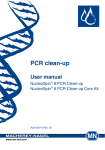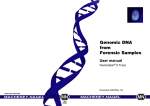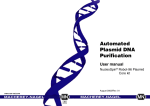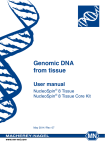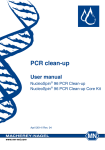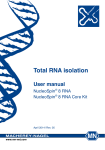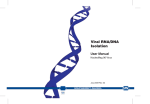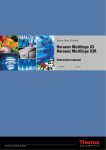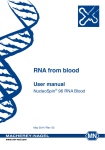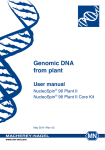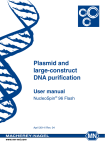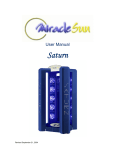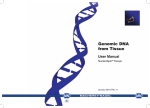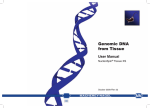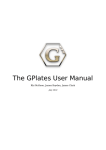Download Genomic DNA from Blood
Transcript
Genomic DNA from Blood User Manual NucleoSpin® 8 Blood NucleoSpin® 96 Blood NucleoSpin® 96 Blood Core Kit February 2009/ Rev. 05 MACHEREY-NAGEL MN Genomic DNA from Blood Table of contents 1 Components 4 1.1 Kit contents 4 1.2 Reagent to be supplied by user 6 1.3 Accessories supplied by user - NucleoSpin 96 Blood Core Kit 7 1.4 Required hardware 8 1.5 Suitable vacuum manifolds 8 Product description 9 2.1 The basic principle 9 ® 2 2.2 Kit specifications 9 2.3 Elution procedure 12 2.4 Automated processing on robotic platforms 13 3 Storage conditions and preparation of working solutions 14 4 Safety instructions – risk and safety phrases 16 5 General procedure 17 5.1 NucleoSpin 8 Blood, vacuum processing 21 5.2 NucleoSpin® 96 Blood, vacuum processing 24 ® 5.3 NucleoSpin 8 / 96 Blood, support protocol for centrifuge processing 27 5.4 Support protocol for modified lysis of blood samples 28 5.5 Support protocol for cultured animal or human cells 29 Appendix 30 6.1 Troubleshooting 30 ® 6 6.2 Ordering information 32 6.3 Reference 34 6.4 Product use restriction / warranty 34 MACHEREY-NAGEL – 02 / 2009, Rev. 05 3 Genomic DNA from Blood 1 Components 1.1 Kit contents NucleoSpin® 8 Blood 12 x 8 preps 60 x 8 preps 740664 740664.5 Lysis Buffer BQ1 40 ml 2 x 100 ml Wash Buffer B5 (Concentrate)1 100 ml 5 x 100 ml Wash Buffer BW 150 ml 2 x 375 ml Elution Buffer BE2 50 ml 2 x 125 ml Proteinase K (lyophilized)1 75 mg 5 x 75 mg Proteinase Buffer PB 3.6 ml 18 ml NucleoSpin® Blood Binding Strips (red rings) 12 60 MN Wash Plates3 1 5 Rack of Tube Strips4 1 5 Cap Strips 12 60 Tubes (2 ml) for Proteinase K 4 20 Tubes (15 ml) for BioRobot 9604 8 40 1 1 Cat. No. ® User Manual Material supplied by user: Suitable lysis tubes or plates, e.g. Rack of Tube Strips with Cap Strips (Cat. No. 740477, 4 sets; see ordering information). 1 For preparation of working solutions and storage conditions see section 3. 2 Elution Buffer BE: 5 mM Tris/HCl, pH 8.5 3 For use with vacuum only 4 Set of 1 rack, 12 strips with 8 tubes each, Cap Strips included 4 MACHEREY-NAGEL – 02 / 2009, Rev. 05 Genomic DNA from Blood 1.1 Kit contents continued NucleoSpin® 96 Blood 1 x 96 preps 4 x 96 preps 24 x 96 preps1 740665.1 740665.4 740665.24 Lysis Buffer BQ1 40 ml 125 ml 6 x 125 ml Wash Buffer B5 (Concentrate)2 100 ml 4 x 100 ml 24 x 100 ml Wash Buffer BW 125 ml 2 x 300 ml 12 x 300 ml Elution Buffer BE3 50 ml 125 ml 6 x 125 ml Proteinase K (lyophilized)2 75 mg 4 x 75 mg 24 x 75 mg Proteinase Buffer PB 3.6 ml 15 ml 6 x 15 ml NucleoSpin® Blood Binding Plates (red rings) 1 4 24 MN Wash Plates4 1 4 24 Lysis Blocks 1 4 24 Rack of Tube Strips5 1 4 24 Tubes (2 ml) for Proteinase K 4 16 96 Tubes (15 ml) for BioRobot® 9604 8 32 192 User Manual 1 1 6 Cat. No. 1 The kit for 24 x 96 preparations (Cat.No. 740665.24) consists of 6 x Cat. No. 740665.4. 2 For preparation of working solutions and storage conditions see section 3. 3 Elution Buffer BE: 5 mM Tris/HCl, pH 8.5 4 For use with vacuum only 5 Sets of 1 rack, 12 strips with 8 tubes each, including Cap Strips MACHEREY-NAGEL – 02 / 2009, Rev. 05 5 Genomic DNA from Blood 1.1 Kit contents continued NucleoSpin® 96 Blood Core Kit 4 x 96 preps Cat. No. 740456.4 Lysis Buffer BQ1 125 ml Wash Buffer B5 (Concentrate)1 4 x 100 ml Wash Buffer BW 2 x 300 ml Elution Buffer BE2 125 ml Proteinase K (lyophilized)1 4 x 75 mg Proteinase Buffer PB 15 ml NucleoSpin® Blood Binding Plates (red rings) 4 User Manual 1 Additional material required (see section 1.3). 1.2 • Reagent to be supplied by user 96 - 100 % ethanol (for preparation of working solutions; see section 3) 1 For preparation of working solutions and storage conditions see section 3. 2 Elution Buffer BE: 5 mM Tris/HCl, pH 8.5 6 MACHEREY-NAGEL – 02 / 2009, Rev. 05 Genomic DNA from Blood 1.3 Accessories supplied by user - NucleoSpin® 96 Blood Core Kit The NucleoSpin® 96 Blood Core Kit provides the buffers, Proteinase K, and NucleoSpin® Blood Binding Plates only. Accessory plates (e.g. lysis plates, elution plates) are not provided with the core kits. The user can individually select additional consumables from a variety of suitable accessory plates according to his requirements for highest flexibility. For usage of NucleoSpin® 96 Blood Core Kit follow the standard protocol (see section 5.2 and 5.3). Recommended accessories for use of the NucleoSpin® 96 Blood Core Kits are available from MACHEREY-NAGEL (see ordering information): Protocol step Suitable consumables, not supplied with the core kits Lysis 4 x Lysis Block per 4x96 preps Remarks or 4 x Round-well Block with Cap Strips per 4x96 preps or Round-well Blocks and Tube Strips can be closed with Cap Strips. 4 x Rack of Tube Strips with Cap Strips per 4x96 preps Binding of DNA to the membrane Elution 4 x MN Wash Plate per 4x96 preps MN Wash Plate minimizes the risk of cross contamination (vacuum processing only). 2 x MN Square-well Block For waste collection during centrifugation (reusable) 4 x Rack of Tubes Strips with Cap Strips per 4x96 preps or Round-well Blocks and Tube Strips can be closed with Cap Strips. 4 x Round-well Block with Cap Strips per 4x96 preps MACHEREY-NAGEL – 02 / 2009, Rev. 05 7 Genomic DNA from Blood 1.4 Required hardware Vacuum processing The NucleoSpin® 8 / 96 Blood kits can be used manually with the NucleoVac 96 Vacuum Manifold (see ordering information). Alternatively, other suitable vacuum manifolds may be used. For processing the 8-well strips the Starter Set A (see ordering information), containing Column Holders A and NucleoSpin® Dummy Strips is required. For automation on laboratory platforms with standard 96-well plate vacuum chambers the use of the Starter Set A is also required. Centrifugation For centrifugation a microtiterplate centrifuge is required which is able to accommodate the NucleoSpin® Blood Binding Strips / Plate stacked on a Round- or Square-well Block and reaches accelerations of 5,600 - 6,000 x g (bucket height: 85 mm), e.g. Hermle Z513, Qiagen/Sigma 4-15c, Jouan KR4i, Kendro-Heraeus Multifuge 3/3-R, HighplateTM, Beckman Coulter, Allegra R25). For processing the 8-well strips the Starter Set C (see ordering information), containing Column Holders C, NucleoSpin® Dummy Strips, MN Square-well Blocks, Rack of Tube Strips is required. 1.5 Suitable vacuum manifolds The NucleoSpin® 8/96 Blood kits can be used with the NucleoVac 96 Vacuum Manifold or other common vacuum devices. For further details see list below. Vacuum manifold Suitability Additional equipment NucleoVac 96 Yes Starter Set A for NucleoSpin® 8 Blood Qiagen / QIAvac 961 Yes MN Frame (see ordering information), Starter Set A for NucleoSpin® 8 Blood Promega / Vac-Man® 962 Yes NucleoSpin® 96 Blood only! In general the QIAvac 96 is suitable for the use with the NucleoSpin® Blood Binding Strips / Plate. Nevertheless, it is recommended to use the MN Frame to adjust the proper height of the MN Wash Plate and Elution Plate in order to ensure best performance. 1 2 MN Wash Plate cannot be used. 8 MACHEREY-NAGEL – 02 / 2009, Rev. 05 Genomic DNA from Blood 2 Product description 2.1 The basic principle With the NucleoSpin® 8 / 96 Blood method, genomic DNA is prepared from whole blood, buffy coat, or cultured cells. Lysis is achieved by incubation of whole blood in a lysis buffer containing chaotropic ions in the presence of Proteinase K at room temperature. For optimal lysis a microplate shaker is recommended. Appropriate conditions for binding of DNA to the silica membrane in the NucleoSpin® Blood Binding Strips or Plate are created by addition of ethanol to the lysate. The binding process is reversible and specific to nucleic acids. Contaminations are removed by three wash steps with ethanolic buffers. Pure genomic DNA is finally eluted under low ionic strength conditions in a slightly alkaline elution buffer. 2.2 Kit specifications • NucleoSpin® 8 / 96 Blood kits are designed for the rapid, small-scale preparation of highly pure genomic DNA from whole animal or human blood, serum, plasma, or other body fluids. The obtained DNA can be used directly as template for PCR, blotting, or any kind of enzymatic reactions. • The kits provide reagents and consumables for purification of up to 20 µg (average 4 - 6 µg) of pure genomic DNA from 200 µl whole blood with an A260/A280 ratio between 1.8 and 1.9 and a typical concentration of 20 - 60 ng / µl. • Fresh and frozen blood and blood treated either with EDTA, citrate, or heparin can be used. The procedure is optimized for a sample volume of 200 µl. Using the NucleoSpin® 8 / 96 Blood kits allows simultaneous processing of up to 96 samples typically within less than 70 minutes. • NucleoSpin® 8 / 96 Blood kits can be processed completely at room temperature. • NucleoSpin® 8 / 96 Blood can be processed by vacuum or centrifugation. The kits allow for easy automation on common liquid handling instruments. For more information about the automation process and the availability of readyto-run scripts for certain platforms please refer to section 2.4 and contact your local distributor or MN directly. • The NucleoSpin® 8 / 96 Blood kits allow for the purification of multiples of 8 (NucleoSpin® 8 Blood) or 96 samples (NucleoSpin® 96 Blood). Both kits are supplied with accessory plates for highest convenience. The NucleoSpin® 96 Blood Core Kit provides the buffers, Proteinase K and NucleoSpin® Blood Binding Plate only. Accessory components (e.g. lysis plates, elution plates) are not provided with the core kit but can be individually selected from a variety of suitable accessories (see section 6.2 for further information). This allows highest flexibility for the user. MACHEREY-NAGEL – 02 / 2009, Rev. 05 9 Genomic DNA from Blood Table 1: Kit specifications at a glance Parameters NucleoSpin® 8 / 96 Blood (Core) Sample material Up to 200 µl Typical DNA yield 4 - 6 µg Elution volume 100 µl DNA binding capacity 20 µg A260 /A280 1.8 - 1.9 Preparation time for 6 strips or 1 plate 35 min Application data Figure 1: DNA isolation from human blood samples Genomic DNA from 200 µl of human blood (96 samples) was isolated using NucleoSpin® 96 Blood on a Tecan Genesis instrument. Of each eluate (100 µl elution volume) 20 µl were loaded and analyzed on a 0.7 % agarose gel. Highly reproducible yields of high-quality genomic DNA were obtained. 10 MACHEREY-NAGEL – 02 / 2009, Rev. 05 Genomic DNA from Blood Fluorescence (F1) 10 8 samples (undiluted) 6 4 2 no template control 0 10 20 30 40 50 Cycle number Figure 2: Analysis of purified DNA by real time PCR (LightCycler) Genomic DNA from 200 µl of blood (96 samples) was isolated using NucleoSpin® 96 Blood on a Tecan Genesis instrument. 2 µl of eluate (100 µl elution volume) were amplified with the LightCycler – SYBR Green I kit and 28S primers (0.5 µM). All samples were amplified with homogenous crossing point values. Amplification plots indicate the absence of inhibitors. + - + - + - + - + - + - + - + - + - + - + - + + - + - + - + - + - + - + - + - + - + - + - + Figure 3: Cross-contamination analysis Genomic DNA was purified from 200 µl of blood using NucleoSpin® 96 Blood on a Biomek 2000 (Beckman Coulter) instrument. Blood samples and PBS buffer were arrayed in a checkerboard pattern. For PCR detection of genomic DNA 2 µl of eluate were amplified on iCycler (BIORAD) with Haemochromatosis-Primer and Taq Polymerase (Life Technologies). 35 cycles were performed. 48 samples were analyzed. No crosscontamination was detected. + : samples containing 200 µl of blood - : control samples without blood (next to a well containing blood) MACHEREY-NAGEL – 02 / 2009, Rev. 05 11 Genomic DNA from Blood 2.3 Elution procedure Recovery of gDNA from the membrane depends on the elution volume. Elution volumes of 50 - 200 µl are possible, with an optimum of 100 - 125 µl dispensed volume. The purity is not effected by the elution volume. See table for correlation between dispensed elution buffer volume and typical recoveries following the standard protocol. Table 2: Recovery volumes in correlation to applied elution volumes Dispensed elution volume 40 µl 60 µl 80 µl 100 µl 120 µl Vacuum 25 µl 45 µl 65 µl 85 µl 105 µl Centrifuge 38 µl 58 µl 78 µl 98 µl 118 µl Recovered volume: 40 30 20 DNA recovered, µg Concentration, ng/µl 50 5 100 4 80 3 60 2 40 1 20 25 50 75 100 125 150 175 200 Recovery, % If highest yield is required, prewarming of the elution buffer to 70 °C will give about 10 15 % higher yields by supporting DNA recovery from the membrane. 0 Dispensed elution buffer, µl 35 60 85 110 135 160 185 Recovered elution buffer, µl Figure 4: Elution of genomic DNA (vacuum processing) Total DNA yield, recovery (- ■ -) and concentration of recovered DNA (- ● -) are plotted versus dispensed elution buffer volume. High elution buffer volumes result in high elution efficiency whereas high concentrated DNA solutions can be obtained with smaller elution buffer volumes. The dead volume of the silica membrane under vacuum is approximatively 15 µl. 12 MACHEREY-NAGEL – 02 / 2009, Rev. 05 Genomic DNA from Blood 2.4 Automated processing on robotic platforms NucleoSpin® 8 / 96 Blood can be fully automated on many common laboratory workstations. For the availability of scripts and general considerations about adapting NucleoSpin® 8 / 96 Blood on a certain workstation please contact MN. Full processing under vacuum enables complete automation without the need for centrifugation steps for drying of the membrane or for elution. The risk of cross-contamination is reduced by optimized vacuum settings during the elution step and by the improved shape of the outlets of the NucleoSpin® 8 / 96 Blood Binding Strips / Plate. Drying of the NucleoSpin® 8 / 96 Blood Binding Strips / Plate under vacuum is sufficient because the bottom of the strips/plate is protected from spraying wash buffer during the washing steps by the MN Wash Plate. Thus, if possible, the MN Wash Plate should be integrated into the automated procedure. The MN Frame (see ordering information) can be used to position the MN Wash Plate inside the vacuum chamber. Thorough cleaning of the vacuum chamber is recommended after each run to prevent forming of gDNA-containing aerosols. Visit MN on the internet at www.mn-net.com or contact your local MACHEREY-NAGEL distributor for technical support regarding hardware, software, setup instruc-tions and selection of the protocol. Several application notes of the NucleoSpin® 8 / 96 Blood kit on various automation workstations can also be found at www.mn-net.com at Bioanalyis / Literature. 10 2 DNA purity (A260/A280) DNA yield (µg) 8 6 4 1 2 0 0 0 8 16 24 32 40 48 45 Number of sample 64 72 80 88 96 0 8 16 24 32 40 48 45 64 72 80 88 96 Number of sample Figure 5: Automated DNA isolation from human blood samples DNA was purified from 96 aliquots from the same blood using NucleoSpin® 96 Blood on a Tecan Genesis 150 instrument (vacuum processing). The average yield is 6.76 µg ± 0.71 with a coefficient of variation (CV) of 10 %. The average purity is 1.97 ± 0.02 (CV: 1 %). MACHEREY-NAGEL – 02 / 2009, Rev. 05 13 Genomic DNA from Blood 3 Storage conditions and preparation of working solutions Attention: Buffers BQ1 and BW contain guanidinium hydrochloride! Wear gloves and goggles when handling them! • All components of the NucleoSpin® 8 / 96 Blood kits should be stored at room temperature for a maximum of 1 year. Storage at lower temperatures may cause precipitation of salts. If a salt precipitation is observed, incubate the bottle at 30 - 40 °C for some minutes and mix well until all of the precipitate is redissolved. Before starting with any NucleoSpin® 8 / 96 Blood kit procedure prepare the following: • Wash Buffer B5: Add the indicated volume of 96 - 100 % ethanol to the Buffer B5 Concentrate. Mark the label of the bottle to indicate that ethanol is added. Store Wash Buffer B5 at room temperature (20 - 25 °C) for up to one year. • Before first use of the kit, add the indicated volume of Proteinase Buffer to lyophilized Proteinase K. Proteinase K solution is stable at - 20 °C for 6 months. NucleoSpin® 8 Blood Cat. No. Wash Buffer B5 (Concentrate) Proteinase K (lyophilized) 14 12 x 8 preps 60 x 8 preps 740664 740664.5 100 ml Add 400 ml ethanol 5 x 100 ml Add 400 ml ethanol to each bottle 75 mg Add 3.35 ml Proteinase Buffer 5 x 75 mg Add 3.35 ml Proteinase Buffer to each bottle MACHEREY-NAGEL – 02 / 2009, Rev. 05 Genomic DNA from Blood NucleoSpin® 96 Blood Cat. No. Wash Buffer B5 (Concentrate) Proteinase K (lyophilized) 1 x 96 preps 4 x 96 preps 24 x 96 preps* 740665.1 740665.4 740665.24 100 ml Add 400 ml ethanol 4 x 100 ml Add 400 ml ethanol to each bottle 24 x 100 ml Add 400 ml ethanol to each bottle 75 mg Add 3.35 ml Proteinase Buffer to each vial 4 x 75 mg Add 3.35 ml Proteinase Buffer to each bottle 24 x 75 mg Add 3.35 Proteinase Buffer to each bottle NucleoSpin® 96 Blood Core Kit 4 x 96 preps Cat. No. Wash Buffer B5 (Concentrate) Proteinase K (lyophilized) 740456.4 4 x 100 ml Add 400 ml ethanol to each bottle 4 x 75 mg Add 3.35 ml Proteinase Buffer to each bottle * The kit of 24 x 96 preparations (Cat .No. 740665.24) consists of 6 x Cat. No. 740665.4. MACHEREY-NAGEL – 02 / 2009, Rev. 05 15 Genomic DNA from Blood 4 Safety instructions – risk and safety phrases The following components of the NucleoSpin® 8 / 96 Blood kits contain hazardous contents. Wear gloves and goggles and follow the safety instructions given in this section. Component Hazard contents Hazard symbol Risk phrases Safety phrases BQ1 Guanidine hydrochloride Xn* Harmful if swallowed - Irritating to eyes and skin R 2236/38 BW Guanidine hydrochloride + isopropanol < 25 % Xn* Flammable - Harmful by if swallowed - Irritating to eyes and skin R 10-2236/38 S 7-16-25 Proteinase K Proteinase K, lyophilized Xn Xi* Irritating to eyes, respiratory system and skin - May cause sensitization by inhalation. R 36/37/3842 S 22-2426-36/37 Risk phrases R 10 Flammable R 22 Harmful if swallowed R 36 / 37 / 38 Irritating to eyes, respiratory system and skin R 36 / 38 Irritating to eyes and skin R 42 May cause sensitization by inhalation Safety phrases S7 Keep container tightly closed S 16 Keep away from sources of ignition - No smoking! S 22 Do not breathe dust S 24 Avoid contact with the skin S 25 Avoid contact with the eyes S 26 In case of contact with eyes, rinse immediately with plenty of water and seek medical advice S 36 / 37 Wear suitable protective clothing and gloves * Hazard labeling not neccessary if quantity per bottle below 125 g or ml (certificate of exemption according to 67/548/EEC Art. 25, 1999/45/EC Art. 12 and German GefStoffV § 20 (3) and TRGS 200 7.1). For further information see Material Safety Data Sheet. 16 MACHEREY-NAGEL – 02 / 2009, Rev. 05 NucleoSpin® 8 Blood 5 General procedure NucleoSpin® 8 Blood, vacuum processing (For details on each step see section 5.1.) Before starting the preparation: • 1 Check if Wash Buffer B5 and Proteinase K were prepared according to section 3. 200 µl blood (equilibrated to room temperature) Lyse samples 25 µl Proteinase K 200 µl BQ1 Mix 3 times Incubate at RT 10 min or Mix 3 times and shake at 1250 rpm at RT 10 min 2 Adjust DNA binding conditions e.g. Rack of Tube Strips with Cap Strips (not supplied with the kit) 200 µl ethanol Mix at least 3 - 5 times Note: High-speed pipetting (400 µl / s) should be used for optimized mixing, if possible. 3 Load samples Transfer samples to NucleoSpin® Blood Binding Strips 4 Overlay with Buffer B5 5 Bind DNA to silica membrane 150 µl B5 - 0.2 bar* 5 min Column Holder A with NucleoSpin® Blood Binding Strips and MN Wash Plate * Reduction of atmospheric pressure MACHEREY-NAGEL – 02 / 2009, Rev. 05 17 NucleoSpin® 8 Blood 6 Wash silica membrane 600 µl BW - 0.2 bar* 3 min 900 µl B5 - 0.2 bar* 1 min 900 µl B5 Column Holder A with NucleoSpin® Blood Binding Strips and MN Wash Plate - 0.2 bar* 1 min 7 Dry silica membrane Remove MN Wash Plate - 0.6 bar* 10 min 8 Elute DNA 50 - 200 µl BE (Incubate 5 min) - 0.6 bar* 1 min * Reduction of atmospheric pressure 18 MACHEREY-NAGEL – 02 / 2009, Rev. 05 Column Holder A with NucleoSpin® Blood Binding Strips on Rack of Tube Strips NucleoSpin® 96 Blood NucleoSpin® 96 Blood, vacuum processing (For details on each step see section 5.2.) Before starting the preparation: • 1 Check if Wash Buffer B5 and Proteinase K were prepared according to section 3. 200 µl blood (equilibrated to room temperature) Lyse samples 25 µl Proteinase K 200 µl BQ1 Mix 3 times Incubate at RT 10 min or Lysis Block Mix 3 times and shake at 1250 rpm at RT 10 min 2 Adjust DNA binding conditions 200 µl ethanol Mix at least 3 - 5 times Note: High-speed pipetting (400 µl / s) should be used for optimized mixing, if possible. 3 Load samples Transfer samples to NucleoSpin® Blood Binding Plate 4 Overlay with Buffer B5 150 µl B5 NucleoSpin® Blood Binding Plate and MN Wash Plate MACHEREY-NAGEL – 02 / 2009, Rev. 05 19 NucleoSpin® 96 Blood 5 Bind DNA to silica membrane - 0.2 bar* 5 min 6 Wash silica membrane 600 µl BW - 0.2 bar* 3 min 900 µl B5 - 0.2 bar* 1 min NucleoSpin® Blood Binding Plate and MN Wash Plate 900 µl B5 - 0.2 bar* 1 min 7 Dry silica membrane Remove MN Wash Plate - 0.6 bar* 10 min 8 Elute DNA 50 - 200 µl BE (Incubate 5 min) - 0.6 bar* 1 min * Reduction of atmospheric pressure 20 MACHEREY-NAGEL – 02 / 2009, Rev. 05 NucleoSpin® Blood Binding Plate on Rack of Tube Strips NucleoSpin® 8 Blood 5.1 NucleoSpin® 8 Blood, vacuum processing For processing of NucleoSpin® 8 Blood under vacuum the NucleoVac 96 Vacuum Manifold and the Starter Kit A are required (see ordering information). Starter Kit A contains the Column Holders A and the NucleoSpin® Dummy Strips to close unused rows of the Column Holder A. Alternatively, other suitable vacuum manifolds can be used. The use of NucleoSpin® Blood Binding Strips in a Column Holder A allows the isolation of up to n x 8 samples (n = 1 to 6). Insert as many of the NucleoSpin® Blood Binding Strips as required into the reusable column holder and place it onto an MN Square-well Block. Before starting the preparation: • Check if Wash Buffer B5 and Proteinase K were prepared according to section 3. Lysis tubes are not supplied with the NucleoSpin® 8 Blood kit. Lysis can be performed in any appropriate microtube or in suitable 96-well plates. We recommend usage of the Lysis Block or Rack of Tube Strips with Cap Strips (see ordering information). 1 Lyse samples Dispense 25 µl Proteinase K and 200 µl blood (equilibrated to room temperature) to each lysis tube / well. Add 200 µl Buffer BQ1 to each lysis tube / well, mix 3 times by pipetting up and down and incubate samples at least 10 min at room temperature. or: Add 200 µl Buffer BQ1 to each tube / well. Mix 3 times by pipetting up and down and shake samples during incubation. Recommended are 10 min at 1250 rpm. Shake at room temperature. Prepare the NucleoVac 96 Vacuum Manifold Place waste tray into vacuum manifold base. Insert spacers labeled “MTP/ Multi-96 plate” notched side up and rest the MN Wash Plate on them. Close the manifold with the manifold lid. MACHEREY-NAGEL – 02 / 2009, Rev. 05 21 NucleoSpin® 8 Blood Insert desired number of NucleoSpin® Blood Binding Strips in the Column Holder A. Use NucleoSpin® Dummy Strips to close unused openings in the column holder. Place Column Holder A with inserted NucleoSpin® Blood Binding Strips on top of the manifold. 2 Adjust DNA binding conditions Add 200 µl 96 - 100 % ethanol to each lysis tube/well, mix at least 3 times. High-speed pipetting (400 µl / sec) should be used for optimal mixing. 3 Load samples Transfer the samples to the NucleoSpin® Blood Binding Strips. Note: Do not moisten the rims of the individual wells while dispensing the samples, as this may lead to cross-contamination. 4 Overlay with Buffer B5 Overlay crude lysate on the NucleoSpin® Blood Binding Strips slowly (50 µl / s) with 150 µl Buffer B5. 5 Bind DNA to silica membrane Apply vacuum until all lysates have passed through the wells of the NucleoSpin® Blood Binding Strips (- 0.2 bar*; 5 min). Release the vacuum. 6 Wash silica membrane 1st wash Add 600 µl Buffer BW to each well of the NucleoSpin® Blood Binding Strips. Apply vacuum (- 0.2 bar*; 3 min) until all buffer has passed through the wells of the NucleoSpin® Blood Binding Strips. Release the vacuum. 2nd wash Add 900 µl Buffer Buffer B5 to each well of the NucleoSpin® Blood Binding Strips. Apply vacuum (- 0.2 bar*; 1 min) until all buffer has passed through the wells of the NucleoSpin® Blood Binding Strips. Release the vacuum. * Reduction of atmospheric pressure 22 MACHEREY-NAGEL – 02 / 2009, Rev. 05 NucleoSpin® 8 Blood 3rd wash Add 900 µl Buffer Buffer B5 to each well of the NucleoSpin® Blood Binding Strips. Apply vacuum (- 0.2 bar*; 1 min) until all buffer has passed through the wells of the NucleoSpin® Blood Binding Strips. Release the vacuum. 7 Remove MN Wash Plate After the final washing step close the valve, release the vacuum and remove the Column Holder A with inserted NucleoSpin® Blood Binding Strips from the vacuum manifold. Put it on a clean paper towel to remove residual EtOH-containing wash buffer. Remove manifold lid, MN Wash Plate, and waste container from the vacuum manifold. Dry silica membrane Remove any residual washing buffer from the outlets of the NucleoSpin® Blood Binding Strips. If necessary, tap the outlets onto a clean paper sheet (supplied with the MN Wash Plate) or soft tissue until no drops come out. Insert the Column Holder A with the NucleoSpin® Blood Binding Strips again into the lid and close the manifold. Apply maximum vacuum (at least - 0.6 bar*) for 10 min to dry the membrane completely. This step is necessary to eliminate traces of ethanol. Note: The ethanol in Buffer B5 inhibits enzymatic reactions and has to be removed completely before eluting DNA. Finally, release the vacuum. 8 Elute DNA Insert spacers “Microtube rack” into the NucleoVac 96 Vacuum Manifold‘s short sides. Place a Rack of Tube Strips onto the spacer. Close the vacuum manifold and place the Column Holder A with the NucleoSpin® Blood Binding Strips on top. Dispense 50 - 200 µl Buffer BE directly to the bottom of each well. Incubate for 5 min at room temperature. Apply vacuum for elution (- 0.6 bar*; 1 min). Dismantle the vacuum manifold and close Tube Strips with Cap Strips for storage. Optional: Preheat Buffer BE to 70 °C to increase yield. * Reduction of atmospheric pressure MACHEREY-NAGEL – 02 / 2009, Rev. 05 23 NucleoSpin® 96 Blood 5.2 NucleoSpin® 96 Blood, vacuum processing For processing of NucleoSpin® 96 Blood under vacuum the NucleoVac 96 Vacuum Manifold is required (see ordering information). Alternatively other suitable vacuum manifolds may be used. Before starting the preparation prepare Buffer B5, and Proteinase K solution (see section 3 for details). Before starting the preparation: • 1 Check if Wash Buffer B5 and Proteinase K were prepared according to section 3. Lyse samples Dispense 25 µl Proteinase K and 200 µl blood (equilibrated to room temperature) to each well of the Lysis Block. Add 200 µl Buffer BQ1 to each well, mix 3 times by pipetting up and down and incubate samples at least 10 min at room temperature. or: Add 200 µl Buffer BQ1 to each well. Mix 3 times by pipetting up and down and shake samples during incubation. Recommended are 10 min at 1250 rpm. Shake at room temperature. Prepare the NucleoVac 96 Vacuum Manifold Place waste tray into vacuum manifold base. Insert spacers labeled “MTP/ Multi-96 plate” notched side up and rest the MN Wash Plate on them. Close the manifold with the manifold lid. Place a NucleoSpin® Blood Binding Plate on top of the manifold. 2 Adjust DNA binding conditions Add 200 µl 96 - 100 % ethanol to each well of the Lysis Block, mix at least 3 times. High-speed pipetting (400 µl / s) should be used for optimal mixing. 24 MACHEREY-NAGEL – 02 / 2009, Rev. 05 NucleoSpin® 96 Blood 3 Load samples Transfer the samples from the Lysis Block to the NucleoSpin® Blood Binding Plate. Note: Do not moisten the rims of the individual wells while dispensing the samples, as this might lead to cross-contamination. 4 Overlay with Buffer B5 Overlay crude lysate on the NucleoSpin® Blood Binding Plate slowly (50 µl / s) with 150 µl Buffer B5. 5 Bind DNA to silica membrane Apply vacuum until all lysates have passed through the wells of the NucleoSpin® Blood Binding Plate (- 0.2 bar*; 5 min). Release the vacuum. 6 Wash silica membrane 1st wash Add 600 µl Buffer BW to each well of the NucleoSpin® Blood Binding Plate. Apply vacuum (- 0.2 bar*; 3 min) until all buffer has passed through the wells of the NucleoSpin® Blood Binding Plate. Release the vacuum. 2nd wash Add 900 µl Buffer Buffer B5 to each well of the NucleoSpin® Blood Binding Plate. Apply vacuum (- 0.2 bar*; 1 min) until all buffer has passed through the wells of the NucleoSpin® Blood Binding Plate. Release the vacuum. 3rd wash Add 900 µl Buffer Buffer B5 to each well of the NucleoSpin® Blood Binding Plate. Apply vacuum (- 0.2 bar*; 1 min) until all buffer has passed through the wells of the NucleoSpin® Blood Binding Plate. Release the vacuum. 7 Remove MN Wash Plate After the final washing step close the valve, release the vacuum and remove the NucleoSpin® Blood Binding Plate. Put it on a clean paper towel to remove residual EtOH-containing wash buffer. Remove manifold lid, MN Wash Plate, and waste container from the vacuum manifold. * Reduction of atmospheric pressure MACHEREY-NAGEL – 02 / 2009, Rev. 05 25 NucleoSpin® 96 Blood Dry silica membrane Remove any residual washing buffer from the outlets of the NucleoSpin® Blood Binding Plate. If necessary, tap the outlets onto a clean paper sheet (supplied with the MN Wash Plate) or soft tissue until no further drops come out. Insert the NucleoSpin® Blood Binding Plate into the lid and close the manifold. Apply maximum vacuum (at least - 0.6 bar*) for 10 min to dry the membrane completely. This step is necessary to eliminate traces of ethanol. Note: The ethanol in Buffer B5 inhibits enzymatic reactions and has to be removed completely before eluting DNA. Finally, release the vacuum. 8 Elute DNA Insert spacers “Microtube rack” into the NucleoVac Vacuum Manifold’s short sides. Place a Rack of Tube Strips onto the spacer. Close the vacuum manifold and place the NucleoSpin® Blood Binding Plate on top. Dispense 50 - 200 µl Buffer BE onto the membrane. Incubate for 5 min at room temperature. Apply vacuum for elution (- 0.6 bar*; 1 min). Dismantle the vacuum manifold and close Tube Strips with Cap Strips for storage. Optional: Preheat Buffer BE to 70 °C to increase yield. * Reduction of atmospheric pressure 26 MACHEREY-NAGEL – 02 / 2009, Rev. 05 Processing under centrifugation 5.3 NucleoSpin® 8 / 96 Blood, support protocol for centrifuge processing Although the NucleoSpin® 8 / 96 Blood kit is designed primarily for vacuum processing, centrifuge processing is also possible. NucleoSpin® 8 Blood For processing under centrifugation the Starter Kit C and a suitable centrifuge are required (see section 1.4). For handling of the 8-well strips and the column holders refer to the protocol of the Starter Kit C. The use of NucleoSpin® Blood Binding Strips in a Column Holder C allows the isolation of up to n x 8 samples (n = 1 to 6). Insert as many of the NucleoSpin® Blood Binding Strips as required into the same positions of each one of the two reusable column holders and place column holders onto MN Square-well Block (see ordering information). Label the column holders or 8-well strips for later identification. Always use 2 Column Holders C containing identical numbers of NucleoSpin® Blood Binding Strips for centrifugation. This avoids the need to balance the centrifuge, and allows multiples of 16 samples to be processed in parallel. We recommend inserting the NucleoSpin® Blood Binding Strips around the center of the column holder. Follow the standard protocol as described in section 5.1. The vacuum steps are substituted by centrifugation of the Column Holder C with the NucleoSpin® 8 Blood Strips at 5,600-6,000 x g for 3 min. Drying of the silica membrane is achieved by centrifugation for 10 min after the second Buffer B5 washing step. A separate drying step is not required. During all centrifugation steps the Column Holder C with the NucleoSpin® 8 Blood Strips should be placed on an MN Square-well Block (see ordering information) to collect the waste. During the elution step the Column Holder C with the NucleoSpin® 8 Blood Strips are placed on top of a Rack of Tube Strips. NucleoSpin® 96 Blood Follow the standard protocol as described in section 5.2. The vacuum steps are substituted by centrifugation of the NucleoSpin® Blood Binding Plate at 5,600 - 6,000 x g for 3 min. Drying of the silica membrane is achieved by centrifugation for 10 min after the second Buffer B5 washing step. A separate drying step is not required. During all centrifugation steps the NucleoSpin® Blood Binding Plate should be placed on an MN Square-well Block (see ordering information) to collect the waste. During the elution step the NucleoSpin® Blood Binding Plate is placed on top of a Rack of Tube Strips. MACHEREY-NAGEL – 02 / 2009, Rev. 05 27 Support protocol for modified lysis 5.4 Support protocol for modified lysis of blood samples This modified lysis procedure may be used to increase the yield on some liquid handling instruments e.g. instruments with 4 channel pipetting system or if the recommended mixing speed of 400 µl / s for the addition of ethanol to adjust binding conditions can not be achieved. A Pre-dispense 25 µl of Proteinase K solution to each well of the Lysis Block. B Transfer 200 µl blood (equilibrated to room temperature) to the Lysis Block. Do not moisten the rims of the well. C Add 75 µl Buffer BQ1 to each sample, pipette up and down 3 times and mix by shaking (15 min) at room temperature. Alternatively, pipette up and down 10 times and incubate 15 min at room temperature. D Add 400 µl Buffer BQ1 / ethanol-mix (1:1, v / v) to each well of the Lysis Block, mix at least 2 times and transfer lysate (total volume 700 µl) to the NucleoSpin® Blood Binding Plate. E Overlay crude lysate on the NucleoSpin® Blood Binding Plate slowly (~ 50 µl / s) with 150 µl Buffer B5. Wait for 1 min before applying vacuum for binding. Proceed with DNA binding step. 28 MACHEREY-NAGEL – 02 / 2009, Rev. 05 Suppotr protocol for cultured cells 5.5 Support protocol for cultured animal or human cells Before starting the preparation: A • Check if Wash Buffer B5 and Proteinase K were prepared according to section 3. • Seal unused wells of NucleoSpin® Blood Binding Strips with Self-adhering PEFoil (see ordering information). Harvest cells Harvest cells (maximum starting amount 2 x 106) and pellet them in the lysis vessel by centrifugation (300 x g, 4 min). Remove supernatant and resuspend cell pellets in 200 µl PBS. B Lyse cells Add 25 µl Proteinase K and 200 µl Buffer BQ1 to each well and shake lysis vessel at least 10 min at room temperature. Complete lysis is important for optimal yields. Optional: Add 10 µl RNase (25 mg / ml, not supplied with the kit, see ordering information) to each well after incubation if genomic DNA has to be free of RNA. Proceed with step 2 (Adjust binding conditions) of the standard protocol. MACHEREY-NAGEL – 02 / 2009, Rev. 05 29 Genomic DNA from Blood 6 Appendix 6.1 Troubleshooting Problem Possible cause and suggestions Low concentration of leukocytes in the whole blood sample • Prepare buffy coat from the blood sample. Incomplete cell lysis • Sample not thoroughly mixed with Buffer BQ1 / Proteinase K. Use of a shaker is recommended for optimal results. • Proteinase K digestion not optimal. Do not add Proteinase K directly to Buffer BQ1. • Increase incubation time. Incubate for at least 10 min at RT. Reagents not applied or restored properly • Poor DNA quality or yield Reagents not properly restored. Add the indicated volume of Proteinase Buffer PB to the Proteinase K vial and 96 - 100 % ethanol to Buffer B5 Concentrate and mix. Kit storage • Store aliquots of the reconstituted Proteinase K at - 20 °C. • Store other kit components at room temperature. Storage at low temperatures may cause salt precipitation. • Keep bottles tightly closed in order to prevent evaporation or contamination. Suboptimal elution 30 • Elution efficiencies decrease dramatically if elution is done with buffers with pH < 7.0. Use slightly alkaline elution buffer like Buffer BE (pH 8.5). • Be sure that all of the elution buffer gets into contact with the silica membrane. No drops should stick to the walls of the columns. MACHEREY-NAGEL – 02 / 2009, Rev. 05 Genomic DNA from Blood Clogging of the NucleoSpin® Blood Binding Strip/Plate • Clogging of binding strip / plate Contamination of genomic DNA with RNA If blood samples are too old and clotting occurs clogging of the NucleoSpin® Blood Binding Strip / Plate may appear. Check for blockage of NucleoSpin® Blood Binding Strip / Plate visually or automatically and remove supernatant. Increase time and strength for vacuum processing. Whole blood can be stored for several weeks at 4 °C. Freeze samples at - 20 °C if blood should be stored for a longer periods. RNA carryover • Add 10 µl (25 mg / ml) RNase A to the sample after the incubation of step 2, as recommended for working with fresh, unfrozen cells. Carryover of ethanol Suboptimal performance of DNA in downstream experiments • Be sure to remove all traces of Buffer B5 after the final washing step. Dry the NucleoSpin® Blood Binding Strip / Plate for at least 10 min with maximum vacuum. • Following the final wash step place NucleoSpin® Blood Binding Strip / Plate in an incubator for 10 min at 70 °C to evaporate ethanol. Vacuum pressure is not sufficient Vacuum manifold • Check if the vacuum manifold lid fits tightly on the manifold base if vacuum is turned on. • Make sure that pump works properly and that any in-line filters are not blocked. Buffer volumes are not enough • Buffers are delivered in sufficient, but limited amounts. Calculate the needed buffer volumes and pour an additional amount of 10 % into the reservoirs. • Do not fill back unused buffer from reservoir to the flask to avoid contaminations. Ask MACHEREY-NAGEL technical service for larger buffer volumes. Buffers MACHEREY-NAGEL – 02 / 2009, Rev. 05 31 Genomic DNA from Blood Splattering of eluate • If eluting with vacuum be sure that the distance between the outlets of the NucleoSpin® Blood Binding Strip / Plate and the Tube Strips is minimized. Crosscontamination Sample transfer • 6.2 Be sure that no liquid drops out of the tips while moving the tips. Ordering information Product Cat. No. Pack of NucleoSpin® 8 Blood 740644 12 x 8 preps NucleoSpin® 8 Blood 740644.5 60 x 8 preps NucleoSpin® 96 Blood 740665.1 1 x 96 preps NucleoSpin® 96 Blood 740665.4 4 x 96 preps NucleoSpin® 96 Blood 740665.24 24 x 96 preps NucleoSpin® 96 Blood Core Kit 740456.4 4 x 96 preps Buffer BQ1 740923.1 1l Buffer B5 Concentrate 740921.100 100 ml Buffer BW 740922.500 500 ml Proteinase K 740506 100 mg RNase A 740505 100 mg Lysis Block 740484 4 32 MACHEREY-NAGEL – 02 / 2009, Rev. 05 Genomic DNA from Blood Product Cat. No. Pack of Rack of Tube Strips with Cap Strips 740477 740477.24 4 sets 24 sets Round-well Block with Cap Strips 740475 740475.24 4 sets 24 sets MN Wash Plate 740479 740479.24 4 24 MN Square-well Block 740476 740476.24 4 24 Starter Set A 740682 1 set Starter Set C 740684 1 set MN Frame 740680 1 NucleoVac 96 Vacuum Manifold 740681 1 NucleoVac Vacuum Regulator 740641 1 Self-adhering PE Foil 740676 50 (set consists of 1 Rack, 12 Tube Strips with 8 tubes each, and 12 Cap Strips) (set consists of 1 Round-well Block 12 Cap Strips) (for use of 8-well strips on the NucleoVac 96 and automation platforms) (for use of 8-well strips under centrifugation) (for optimized handling of 96-well plates with vacuum manifold on BioRobot® 9600, 9604, and 3000 (Qiagen), MultiPROBE II (PerkinElmer), Biomek 2000, and FX (Beckman Coulter) MACHEREY-NAGEL – 02 / 2009, Rev. 05 33 Genomic DNA from Blood 6.3 Reference Vogelstein B., and D. Gillespie. 1979. Preparative and analytical purification of DNA from agarose. Proc. Natl. Acad. Sci. USA 76: 615-619. 6.4 Product use restriction / warranty NucleoSpin® 8 / 96 Blood (Core) kit components were developed, designed, distributed, and sold FOR RESEARCH PURPOSES ONLY They are suitable FOR IN - VITRO USES ONLY. No claim or representation is intended for its use to identify any specific organism or for clinical use (diagnostic, prognostic, therapeutic, or blood banking). It is rather the responsibility of the user to verify the use of the NucleoSpin® 8 / 96 Blood (Core) kit for a specific application range as the performance characteristic of this kit has not been verified to a specific organism. This MACHEREY-NAGEL product is shipped with documentation stating specifications and other technical information. MACHEREY-NAGEL warrants to meet the stated specifications. MACHEREY-NAGEL´s sole obligation and the customer´s sole remedy is limited to replacement of products free of charge in the event products fail to perform as warranted. Supplementary reference is made to the general business terms and conditions of MACHEREY-NAGEL, which are printed on the price list. Please contact us if you wish an extra copy. MACHEREY-NAGEL does not warrant against damages or defects arising in shipping and handling (transport insurance for customers excluded), or out of accident or improper or abnormal use of this product; against defects in products or components not manufactured by MACHEREY-NAGEL, or against damages resulting from such nonMACHEREY-NAGEL components or products. MACHEREY-NAGEL makes no other warranty of any kind whatsoever, and SPECIFICALLY DISCLAIMS AND EXCLUDES ALL OTHER WARRANTIES OF ANY KIND OR NATURE WHATSOEVER, DIRECTLY OR INDIRECTLY, EXPRESS OR IMPLIED, INCLUDING, WITHOUT LIMITATION, AS TO THE SUITABILITY, REPRODUCTIVITY, DURABILITY, FITNESS FOR A PARTICULAR PURPOSE OR USE, MERCHANTABILITY, CONDITION, OR ANY OTHER MATTER WITH RESPECT TO MACHEREY-NAGEL PRODUCTS. In no event shall MACHEREY-NAGEL be liable for claims for any other damages, whether direct, indirect, incidental, compensatory, foreseeable, consequential, or special (including but not limited to loss of use, revenue or profit), whether based upon warranty, contract, tort (including negligence) or strict liability arising in connection with the sale or the failure of MACHEREY-NAGEL products to perform in accordance with the stated specifications. This warranty is exclusive and MACHEREY-NAGEL makes no other warranty expressed or implied. The warranty provided herein and the data, specifications and descriptions of this MACHEREY-NAGEL product appearing in MACHEREY-NAGEL published catalogues and product literature are MACHEREY-NAGEL´s sole representations concerning 34 MACHEREY-NAGEL – 02 / 2009, Rev. 05 Genomic DNA from Blood the product and warranty. No other statements or representations, written or oral, by MACHEREY-NAGEL´s employees, agent or representatives, except written statements signed by a duly authorized officer of MACHEREY-NAGEL are authorized; they should not be relied upon by the customer and are not a part of the contract of sale or of this warranty. Product claims are subject to change. Therefore please contact our Technical Service Team for the most up-to-date information on MACHEREY-NAGEL products. You may also contact your local distributor for general scientific information. Applications mentioned in MACHEREY-NAGEL literature are provided for informational purposes only. MACHEREY-NAGEL does not warrant that all applications have been tested in MACHEREY-NAGEL laboratories using MACHEREY-NAGEL products. MACHEREYNAGEL does not warrant the correctness of any of those applications. Please contact: MACHEREY-NAGEL Germany Tel.: +49 (0) 24 21 969 270 e-mail: [email protected] Last updated: 12 / 2006, Rev. 02 Trademarks: BioRobot is a registered trademark of the Qiagen GmbH Corporation Multifuge 3/3-R Highplate is a brand of Hereaus Instrument GmbH & Co. NucleoSpin is a registered trademark of MACHEREY-NAGEL GmbH & Co KG QIAvac 96 is a registered trademark of Qiagen GmbH Corporation Vac-Man is a registered trademark of Promega Corporation All used names and denotations can be brands, trademarks or registered labels of their respective owner – also if they are not special denotation. To mention products and brands is only a kind of information, i.e. it does not offend against trademarks and brands and can not be seen as a kind of recommendation or assessment. Regarding these products or services we can not grant any guarantees regarding selection, efficiency or operation. MACHEREY-NAGEL – 02 / 2009, Rev. 05 35



































